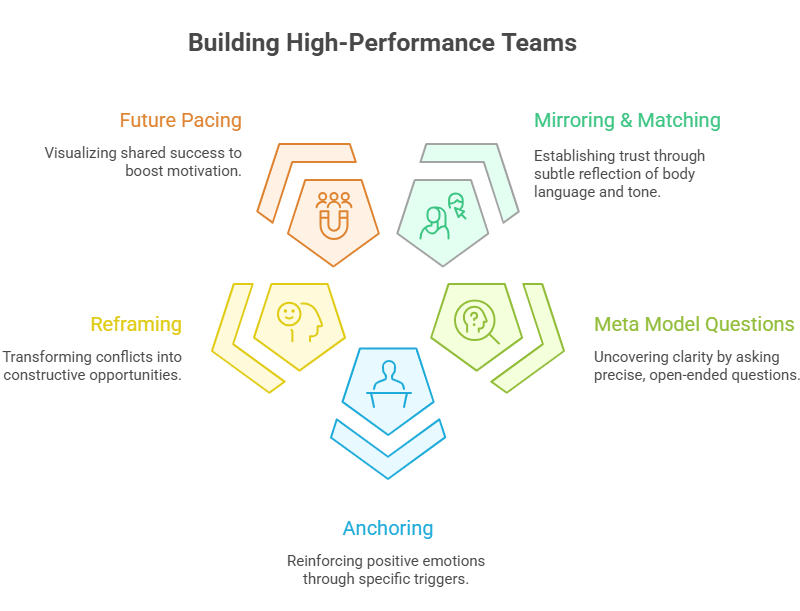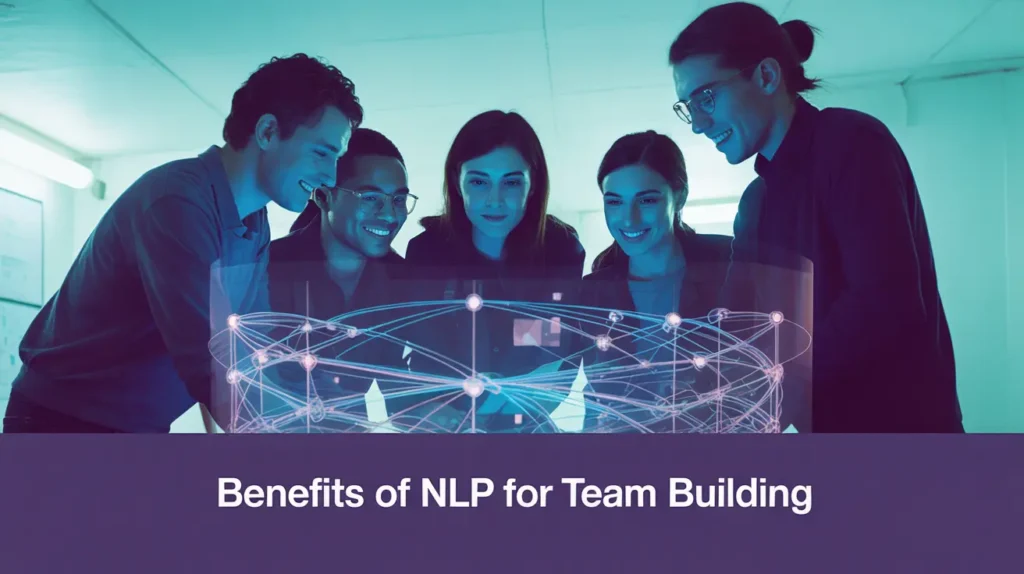Building a high-performing team isn’t just about skills; it’s about communication, trust, and shared goals. NLP (Neuro-Linguistic Programming) gives leaders and teams practical tools to build rapport, resolve conflicts, and stay motivated. By applying techniques such as mirroring, reframing, and future pacing, organizations can transform collaboration and strengthen workplace culture.
Every leader dreams of a team that communicates smoothly, supports each other, and stays aligned on goals. But the reality often looks different; conflicting personalities, unclear communication, and low motivation can get in the way.
This is where Neuro-Linguistic Programming (NLP) comes in. NLP is a powerful approach to understanding human behavior, language, and thought patterns. When applied to team building, it helps teams create trust, reduce misunderstandings, and work toward success together.
By using simple NLP techniques, leaders can turn conflict into collaboration, spark team motivation, and guide members to visualize shared success. If you’ve read our guide on NLP techniques for sales, you’ll see how the same principles can supercharge team dynamics in the workplace.Key Takeaways
- NLP improves teamwork through trust, communication, and motivation.
- Techniques like mirroring, reframing, and future pacing help resolve conflicts and align goals.
- Leaders who use NLP create a culture of collaboration and growth.
What Is NLP in Team Building and Why Does It Matter?
At its core, NLP focuses on how people process information and communicate. In the context of team building, NLP helps members better understand each other’s perspectives and build stronger emotional connections.
Applying NLP in teams allows organizations to:
- Build rapport and trust quickly among diverse members.
- Improve team communication and reduce costly misunderstandings.
- Reframe workplace challenges into opportunities for growth
- Boost motivation and engagement during projects.
- Align individuals with shared goals, strengthening overall performance.
In short, NLP isn’t just a leadership tool; it’s a framework for creating high-functioning, motivated teams.
Top 5 NLP Techniques for Team Building

The top 5 NLP Techniques for Team Building help teams communicate with clarity, build deeper trust, and stay motivated. These techniques make collaboration smoother by reducing conflict and encouraging positive connections. By applying them, leaders can transform group dynamics into a culture of cooperation and growth.
Mirroring & Matching: Build Rapport Quickly
One of the fastest ways to establish trust in a team is through mirroring and matching. This technique involves subtly reflecting another person’s body language, tone, or pace of speech.
For example, if a teammate speaks slowly and pauses often, slowing your own pace helps them feel understood. Similarly, adopting open body language when others do the same builds subconscious trust.
This technique is not about imitation; it’s about creating alignment. When done respectfully, mirroring builds rapport and makes team communication flow naturally. Leaders can use it in meetings, brainstorming sessions, or even in virtual team calls to create an instant connection.
Meta Model Questions: Create Clarity
Teams often get stuck due to vague communication. Someone might say, “This won’t work” or “We don’t have enough time.” These statements lack clarity. NLP’s Meta Model questions dig deeper to uncover real meaning.
For example:
- If a teammate says, “It’s too difficult,” you could ask: “What specifically makes it difficult?”
- If someone says, “We always fail at this,” you could ask: “Always? Can you share when it did work?”
By asking precise, open-ended questions, teams move past assumptions and find solutions. This technique improves collaboration, reduces frustration, and ensures everyone works with clear information.
Anchoring: Reinforce Positive Team States
Great teams thrive on energy, confidence, and motivation. NLP’s anchoring technique connects positive emotions to specific triggers, so they can be reactivated later.
For example, after finishing a big project successfully, a leader might highlight how the team felt excited, proud, and motivated. That state becomes an “anchor.” In future projects, the leader can recall that success, saying: “Remember how we worked together on the last launch? That same energy will help us here.”
Anchoring helps teams manage stress, maintain morale, and stay focused on achievements rather than setbacks. It’s especially powerful in leadership coaching and motivation during tough times.
Reframing: Turn Conflicts Into Opportunities
Conflict is unavoidable in teams but NLP’s reframing technique turns disagreements into constructive conversations, instead of focusing on the negative, reframing shifts perspective.
For instance, if a teammate complains, “This project is overwhelming,” a leader can reframe: “Yes, it’s challenging but it’s also a chance to grow and show what we’re capable of.”
Reframing doesn’t dismiss concerns; it acknowledges them while helping people see a more positive angle. This simple shift can reduce workplace conflict and make teams more solution-focused.
Future Pacing: Visualize Shared Success
People are more motivated when they can clearly picture success. NLP’s future pacing technique helps teams imagine what it feels like to achieve goals together.
For example, a leader might say:
“Imagine six months from now, the project is complete, our clients are thrilled, and the recognition you deserve is on display. How will that feel?”
This visualization motivates teams by making success feel real in advance. It keeps members aligned, boosts team motivation, and strengthens commitment to shared goals.
How to Apply NLP in Everyday Team Settings
Applying NLP in the workplace doesn’t have to feel complicated. By weaving small communication shifts into daily interactions, leaders and teams can foster stronger collaboration, reduce tension, and keep motivation high. Below are practical ways to bring NLP techniques into real scenarios.
In Meetings: Encourage Alignment and Clarity
Team meetings can easily drift into misunderstandings or low engagement. Using mirroring and matching, participants feel more in sync, which helps discussions flow naturally. Leaders can also ask clarifying questions to keep everyone aligned, ensuring that ideas are not dismissed too quickly but examined constructively.
Conflict Resolution: Shift From Friction to Solutions
Disagreements are inevitable, but NLP tools make them less damaging. Instead of reacting to general complaints, use precision questions to uncover specifics. This approach transforms vague frustrations into solvable challenges and allows teams to focus on outcomes rather than conflict.
Brainstorming Sessions: Sustain Creative Flow

Innovation flourishes when team members feel safe to contribute. With anchoring techniques, leaders can connect brainstorming with positive emotions such as excitement or pride. This makes it easier for participants to remain energized and prevents criticism from shutting down new ideas.
Leadership: Model Effective Communication
Leaders set the tone for how communication unfolds. By practicing reframing challenges as opportunities and guiding the team with future pacing, they demonstrate constructive dialogue. Over time, this example encourages the entire group to adopt a more solution-focused mindset.
Benefits of NLP for Team Building

Strong teams don’t just happen; they’re built through trust, communication, and motivation. NLP techniques give leaders and teams practical ways to connect, reduce conflict, and stay aligned on goals. Here are the key benefits NLP brings to team building:
Builds Trust and Collaboration
Through mirroring and rapport-building, NLP helps team members feel understood, which strengthens trust and encourages smoother collaboration.
Improves Communication and Problem-Solving
Meta Model questioning reduces vague statements and assumptions, leading to clearer conversations and faster solutions.
Boosts Motivation and Engagement
Anchoring and future pacing keep energy high by linking team goals with positive emotions and visualizing shared success.
Reduces Conflict and Misunderstandings
Reframing techniques help shift perspectives, turning disagreements into opportunities for constructive dialogue.
Strengthens Leadership Impact
Leaders who apply NLP enhance their ability to inspire, motivate, and guide teams toward higher performance.
Conclusion
NLP in team building is more than just a communication tool; it’s a way to create understanding, trust, and motivation within a group. By practicing techniques like mirroring, Meta Model questioning, anchoring, reframing, and future pacing, leaders can transform how their teams work together.
When NLP is applied consistently, teams become more resilient, conflicts turn into opportunities, and success feels like a shared journey. Leaders who embrace NLP are not just improving communication; they’re shaping a workplace culture built on trust, collaboration, and growth.
If you’re ready to strengthen team communication and motivation, NLP techniques are a powerful place to start.
FAQs
What is NLP in team building?
It’s the use of Neuro-Linguistic Programming techniques to improve communication, trust, and collaboration within teams.
Can NLP help resolve workplace conflicts?
Yes, techniques like reframing and Meta Model questioning turn conflicts into constructive conversations.
Is NLP suitable for remote or hybrid teams?
Absolutely. NLP works in virtual meetings through tone mirroring, goal visualization, and active questioning.
How can leaders introduce NLP to teams?
Start with one simple technique, model it consistently, and encourage reflection to track its impact.





